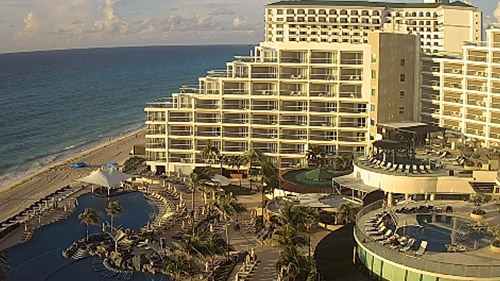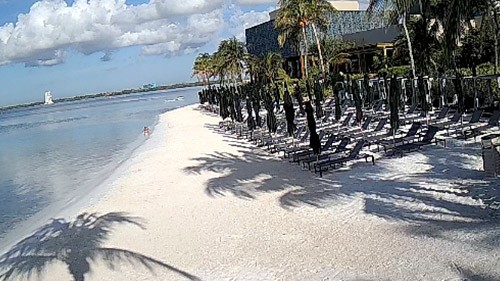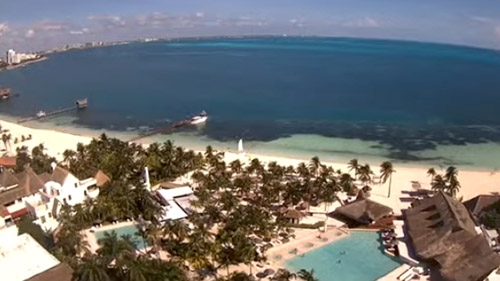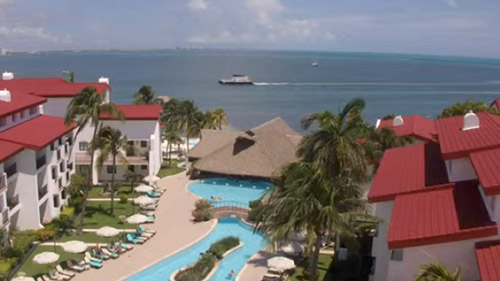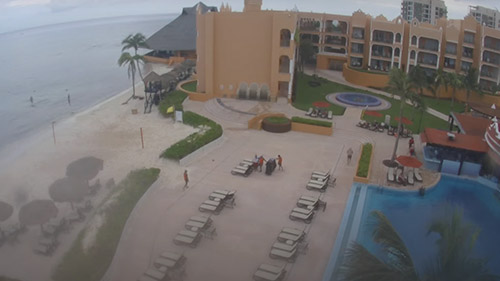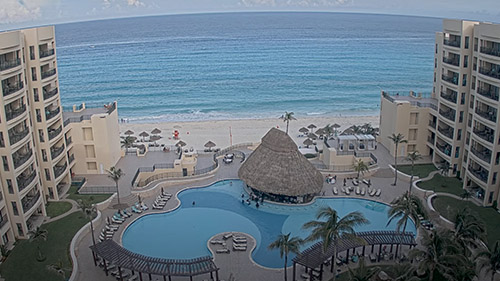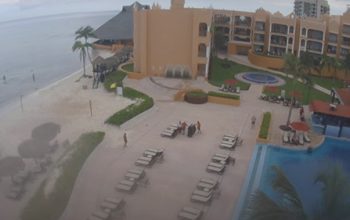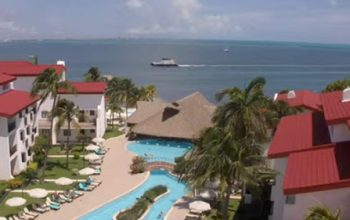These Cancun Mexico Webcams offer gorgeous views of Mexico’s Finest Beaches and All-Inclusive Resorts.
Cancun Mexico Webcams: A Virtual Window
The Cancun Hotel Zone, often called “Zona Hotelera,” is a must-visit destination. Known for its stunning beaches, luxury resorts, and vibrant nightlife, it offers something for everyone. Now, with Cancun Mexico Webcams, you can explore this lively area from anywhere in the world. These live webcams allow you to experience the beauty and excitement of Cancun’s Hotel Zone without leaving your home.
Explore Cancun’s Hotel Zone with Live Webcams
Imagine watching the sunrise over the Caribbean Sea or seeing the bustling nightlife of Cancun from your screen. Cancun Mexico Webcams make this possible. They provide real-time views of Cancun’s most iconic spots. Whether you’re planning a trip or just need a quick escape, these webcams bring Cancun’s magic directly to you.
Why Use Cancun Mexico Webcams?
Cancun Mexico Webcams offer a virtual experience like no other. You can:
- Watch the current weather and sea conditions.
- Explore different beaches before you visit.
- Enjoy a virtual vacation from your living room.
These webcams give you a front-row seat to Cancun’s beauty, anytime you want.
Stunning Beaches Captured by Live Cams
Cancun is famous for its beautiful beaches. Each beach offers something unique, and with Cancun Mexico Webcams, you can see them all. Here are some of the most stunning beaches you can explore:
Playa Delfines
Playa Delfines, known for its wide sandy shores and breathtaking ocean views, is a must-see. This family-friendly beach offers a peaceful escape from the crowds. You can watch the waves roll in and see the famous “Cancun” sign, a perfect spot for photos.
Playa Chac Mool
If you love adventure, Playa Chac Mool is the place to be. This lively beach is ideal for water sports like surfing and parasailing. The energetic waves and active atmosphere are all visible through the live webcam, giving you a taste of the action.
Playa Tortugas
Playa Tortugas is a social hub, attracting both locals and tourists. This beach is perfect for jet skiing, beach volleyball, and other fun activities. The live camera captures the lively energy, making you feel like you’re part of the excitement.
Playa Norte
Playa Norte, located on Isla Mujeres, is known for its calm, shallow waters. It’s an ideal spot for swimming and relaxing. With Cancun Mexico Webcams, you can enjoy the serene beauty of Playa Norte anytime you want.
Playa Las Palmas
Although Playa Las Palmas is near Tulum, just under two hours from Cancun, it’s worth the virtual visit. This beach is near ancient Mayan ruins, offering both historical and natural beauty. The cams lets you experience its tranquility and clear waters from afar.
Playa Langosta
Playa Langosta is great for families, with its gentle waves and shallow waters. The beach’s golden sands and stunning sunsets make it perfect for a day of relaxation. The live cam lets you watch the sunset in real-time, bringing the beauty of Playa Langosta to your screen.
Playa Mujeres
Playa Mujeres is a hidden gem, offering privacy and natural beauty. It’s an excellent choice for couples seeking a romantic getaway. The webcam shows the untouched beauty of Playa Mujeres, allowing you to experience its charm from anywhere.
Akumal Beach
Akumal Beach is famous for its calm waters and the chance to swim with sea turtles. This beach is a paradise for nature lovers and snorkelers. The webcam captures the crystal-clear waters and diverse marine life, letting you explore Akumal’s underwater world virtually.
Benefits of Watching Cancun Mexico Webcams
Cancun Mexico Webcams do more than just provide a visual escape. They offer practical benefits, too:
- Plan Your Trip: See the current conditions before you travel.
- Virtual Escape: Take a break and enjoy the beautiful views from your screen.
- Stay Connected: If you’ve visited Cancun before, relive the memories by watching your favorite spots.
These webcams allow you to experience Cancun’s beauty and excitement whenever you need a getaway.
Experience Cancun Mexico Webcams Anywhere
Cancun’s Hotel Zone is a destination like no other, offering stunning beaches, vibrant culture, and endless fun. Thanks to Cancun Mexico Webcams, you can explore this paradise from anywhere in the world. Whether you’re watching the sunrise at Playa Delfines or the lively scene at Playa Tortugas, these live webcams bring the magic of Cancun directly to you. Start your virtual journey today and let Cancun’s beauty brighten your day, no matter where you are.
Best Things to Do in Cancun, Mexico
Cancun is one of Mexico’s most popular vacation destinations. It offers stunning beaches, exciting nightlife, and plenty of activities for every type of traveler. Whether you love adventure, relaxation, or cultural experiences, Cancun has something for you. Here are some of the best things to do in Cancun.
1. Visit the Interactive Aquarium Cancun
Located in La Isla Shopping Village, the Interactive Aquarium Cancun is perfect for families and marine life lovers. Visitors can explore a variety of sea creatures, including stingrays, sharks, and colorful tropical fish. One of the main attractions is the dolphin encounter, where you can swim, touch, and even kiss these intelligent mammals.
Other experiences include:
- Touch pools where you can interact with starfish and rays
- Aquarium Trek, an underwater walk where you get up close with marine life
- Sea lion shows, where you can see these playful animals perform tricks
This is a great place to learn about marine conservation while having fun.
2. Explore Chichen Itza
No trip to Cancun is complete without visiting Chichen Itza, one of the New Seven Wonders of the World. This ancient Mayan city features the famous El Castillo pyramid, also known as the Temple of Kukulkan. Visitors can explore other fascinating ruins, including the Great Ball Court and the Temple of Warriors.
Tips for visiting:
- Arrive early to avoid the heat and crowds
- Bring water, sunscreen, and a hat
- Consider a guided tour to learn about the history of the site
3. Relax at Playa Delfines
Cancun is famous for its beaches, and Playa Delfines is one of the best. Unlike the busy hotel beaches, this spot offers a more relaxed atmosphere. It is known for its soft white sand and turquoise waters. Plus, it has one of the most Instagrammable spots in Cancun—the colorful Cancun sign.
Things to do at Playa Delfines:
- Swim in the crystal-clear water
- Enjoy a picnic on the sand
- Take photos at the Cancun sign
- Watch the sunrise for a breathtaking view
There are no big resorts here, making it a peaceful escape from the crowds.
4. Snorkel at Isla Mujeres
A short ferry ride from Cancun, Isla Mujeres is a paradise for snorkelers and divers. The island is home to beautiful coral reefs and the Underwater Museum of Art (MUSA), where you can see over 500 submerged sculptures.
Popular snorkeling spots include:
- Manchones Reef – A great place to see tropical fish and coral formations
- El Farito – A shallow reef, perfect for beginners
- MUSA (Underwater Museum of Art) – A unique artificial reef with fascinating sculptures
The island also has beautiful beaches, like Playa Norte, where you can relax in shallow, clear waters.
5. Experience Xcaret Park
For an unforgettable adventure, visit Xcaret Park, an eco-archaeological park that combines nature, culture, and adventure. The park offers:
- Underground rivers where you can swim through caves
- Wildlife exhibits with jaguars, flamingos, and sea turtles
- Cultural performances, including a spectacular night show featuring traditional Mexican music and dance
It’s a must-visit for families and anyone who loves nature and history.
6. Party at Coco Bongo
Cancun is known for its vibrant nightlife, and Coco Bongo is the most famous club in town. It’s more than just a nightclub—it’s a mix of a concert, circus, and dance party. The shows feature live performances, acrobatics, and music from famous artists.
Reasons to visit Coco Bongo:
- High-energy performances
- Open bar with drinks included in the ticket
- Confetti, balloons, and non-stop entertainment
If you love nightlife, this is an experience you can’t miss.
7. Discover the Cenotes
Cenotes are natural sinkholes filled with crystal-clear water, and they are unique to the Yucatán Peninsula. They were considered sacred by the Mayans and are now popular for swimming, diving, and snorkeling.
Top cenotes near Cancun:
- Cenote Dos Ojos – A beautiful cave cenote with stunning rock formations
- Cenote Ik Kil – A famous open cenote near Chichen Itza
- Cenote Azul – A great spot for swimming and cliff jumping
Cenotes are a refreshing escape from the heat and offer an unforgettable experience.
8. Visit the Cancun Underwater Museum (MUSA)
If you love diving or snorkeling, the Cancun Underwater Museum (MUSA) is a must-see. This underwater museum features more than 500 life-sized sculptures, designed to promote coral growth.
Best ways to explore MUSA:
- Snorkeling – Great for beginners who want to see the statues from above
- Scuba diving – Perfect for experienced divers who want a closer look
- Glass-bottom boat tours – A dry option for those who prefer to stay above water
It’s a unique experience that combines art and marine conservation.
Cancun is more than just a beach destination. From exploring ancient Mayan ruins to snorkeling in underwater museums, there are endless things to do. Whether you’re seeking adventure, relaxation, or culture, Cancun has something for everyone. Pack your bags, grab your sunscreen, and get ready for an unforgettable trip to paradise!
The History of Cancun, Mexico: From Ancient Maya to Modern Tourism Hub
Cancun, Mexico, is one of the world’s most famous beach destinations. Known for its stunning turquoise waters and luxurious resorts, it has a deep and fascinating history. From ancient Maya civilizations to Spanish conquests and modern development, Cancun has undergone a massive transformation.
Ancient Maya Settlements
Long before Cancun became a tourist hotspot, it was home to the Maya civilization. The Maya thrived in the Yucatán Peninsula for thousands of years. They built incredible cities, developed advanced calendars, and practiced astronomy. Cancun, along with nearby areas like Tulum and Coba, played an essential role in Mayan trade and culture.
The Maya built many settlements along the coast, including Isla Mujeres and Cozumel. These islands were sacred places, dedicated to the Mayan goddess Ixchel, who represented fertility, medicine, and the moon. Pilgrims traveled to these islands to worship and seek blessings.
Mayan merchants used Cancun’s coast for trade routes. They exchanged goods like jade, obsidian, cacao, and textiles. The region was well-connected with other major Mayan cities, such as Chichen Itza and Uxmal.
Spanish Conquest and Decline of the Maya
In the early 1500s, Spanish explorers arrived in the Yucatán Peninsula. The first contact between the Spanish and the Maya was in 1517 when Francisco Hernández de Córdoba led an expedition along the coast. Soon after, Spanish forces, led by Hernán Cortés and Francisco de Montejo, launched full-scale conquests.
The Maya fiercely resisted Spanish rule, but they eventually fell due to disease, warfare, and forced labor. European diseases like smallpox and measles devastated the indigenous population. Many Mayans fled deeper into the jungle to escape the Spanish, leading to the decline of coastal settlements, including those near present-day Cancun.
By the late 1600s, only small fishing villages and isolated Mayan communities remained in the region. The area that is now Cancun became sparsely populated, with only a few settlements on Isla Mujeres and Cozumel.
Colonial and Post-Independence Era
During the Spanish colonial period (1521–1821), Cancun remained largely undeveloped. The Spanish focused their efforts on larger cities like Mérida and Campeche. The Yucatán Peninsula became known for henequen farming, a fiber used to make ropes and textiles. However, Cancun’s coastal area remained untouched.
After Mexico gained independence in 1821, the Yucatán Peninsula continued to struggle with political instability. Conflicts like the Caste War of Yucatán (1847-1901) saw indigenous Mayans fighting against Mexican and European rule. These conflicts further reduced settlement in the Cancun area.
By the early 20th century, Cancun was still a remote and undeveloped region. The land was mostly covered in jungle, with a few small fishing villages and coconut plantations along the coast.
The Birth of Cancun as a Tourist Destination
In the 1960s, the Mexican government saw potential in Cancun’s pristine beaches and warm climate. At that time, Mexico’s tourism industry mainly revolved around Acapulco. Officials wanted to create a new resort city in an undeveloped area.
In 1967, the Bank of Mexico and the agency INFRATUR (National Fund for Tourism Development) began planning Cancun. The government allocated $2 million USD to study the feasibility of a new tourist destination. The location was chosen because of its beautiful beaches, clear waters, and favorable weather.
At the time, only three people lived on Isla Cancun. They were caretakers of a coconut plantation owned by Don José de Jesús Lima Gutiérrez. Nearby, about 117 people lived in Puerto Juárez, a small fishing village.
Cancun’s Rapid Growth in the 1970s and 1980s
On January 23, 1970, Cancun’s development officially began. The Mexican government financed the construction of the first nine hotels, as private investors were hesitant to invest in an unknown location.
In 1974, Cancun became part of the newly formed state of Quintana Roo. It was designated as an Integrally Planned Center (CIP) under FONATUR, the new name for INFRATUR. Cancun quickly grew into a modern city, attracting workers and tourists from all over the world.
Between 1970 and 1980, Cancun’s population grew at an astonishing rate of 62.3% per year. What was once a quiet fishing area became a bustling tourist hub. By the 1980s, Cancun was competing with Acapulco as Mexico’s top beach destination.
Challenges and Expansion in the 21st Century
Cancun’s success continued into the 2000s, but rapid growth brought new challenges. The city struggled with overpopulation, unregulated construction, and environmental concerns. The local government worked to improve infrastructure, but illegal settlements expanded on the outskirts.
Another major challenge has been sargassum seaweed, which began washing up on Cancun’s beaches in large amounts around 2015. The brown, smelly seaweed affected tourism, but authorities developed methods to clean up the beaches regularly.
Despite these issues, Cancun remains one of the most visited cities in the world. In 2023, a record 21 million tourists visited the city, surpassing expectations.
Cancun Today: A Global Tourism Powerhouse
Today, Cancun is known for its luxury resorts, vibrant nightlife, and world-class beaches. The city has also expanded into eco-tourism, with attractions like Xcaret Park, Isla Contoy, and underwater snorkeling tours.
Cancun’s international airport is one of the busiest in Latin America, connecting travelers from all over the world. The hotel zone continues to grow, with new resorts and entertainment venues opening each year.
Despite its modern appearance, Cancun’s Mayan roots are still visible. Nearby ruins like El Rey, Tulum, and Chichen Itza remind visitors of the region’s rich history. Traditional Mayan culture and cuisine also remain an important part of the local identity.
Cancun’s history is a story of transformation. From its ancient Mayan beginnings to its colonial struggles and rapid rise as a tourist city, Cancun has come a long way. It has evolved from a quiet fishing village to a world-famous travel destination in just a few decades.
While Cancun faces modern challenges, its stunning beaches, rich history, and vibrant culture continue to attract millions of visitors each year. Whether exploring its Mayan past or enjoying its luxurious resorts, Cancun offers something for everyone.
The Geography of Cancun, Mexico: A Tropical Paradise Shaped by Nature
Cancun, Mexico, is a world-famous travel destination known for its white sandy beaches, turquoise waters, and vibrant nightlife. However, beyond its luxurious resorts and bustling hotel zone, Cancun has a fascinating geography. From its coastal formations and barrier reefs to its tropical climate and hurricane history, Cancun’s landscape plays a significant role in shaping the city’s development and appeal.
1. Location and General Layout
Cancun is located in the southeastern part of Mexico on the northeastern coast of the Yucatán Peninsula. It sits along the Caribbean Sea, making it a prime location for tourism. Cancun is part of the state of Quintana Roo, which borders the Mexican states of Yucatán and Campeche to the west and Belize to the south.
The city is divided into two main areas:
1. The Hotel Zone (Zona Hotelera) – A barrier island that stretches 14 miles (22.5 km) along the coastline. This area is home to Cancun’s famous resorts, beaches, and entertainment hubs.
2. Downtown Cancun (El Centro) – The main residential and commercial area of Cancun, located on the mainland. It includes supermanzanas (superblocks), which are large trapezoidal sections of land with centralized green spaces and residential streets.
2. The Mesoamerican Barrier Reef System
One of Cancun’s most stunning natural features is its proximity to the Mesoamerican Barrier Reef System, the second-largest coral reef system in the world (after Australia’s Great Barrier Reef). This reef extends over 620 miles (1,000 km) from Mexico down to Honduras.
The reef provides several benefits to Cancun’s geography:
- Protects the shoreline by acting as a natural barrier against strong waves and storm surges.
- Creates clear, calm waters that make Cancun ideal for snorkeling and scuba diving.
- Supports marine life, including sea turtles, tropical fish, and coral species.
3. Cancun’s Coastal Features
Cancun’s coastline features soft white sand, which is made of crushed coral and limestone. Unlike silica-based sand found in other parts of the world, Cancun’s sand stays cool even under the hot sun.
The Nichupté Lagoon is another important part of Cancun’s geography. It is a vast network of brackish water lagoons that separates the Hotel Zone from the mainland. The lagoon is home to mangroves, crocodiles, and diverse bird species.
Beyond the main city, the coastline extends northward to Puerto Juárez and Punta Sam, where new developments are growing. South of Cancun, the coast continues towards Playa del Carmen and Tulum, both of which have become major tourism destinations.
4. Climate and Weather Patterns
Cancun has a tropical wet and dry climate (Aw in the Köppen climate classification). This means it is warm and humid year-round, with distinct wet and dry seasons.
Average Temperatures
Cancun’s temperatures remain fairly consistent throughout the year:
- Winter (December–February): 75–82°F (24–28°C)
- Spring (March–May): 78–85°F (26–29°C)
- Summer (June–August): 80–88°F (27–31°C)
- Fall (September–November): 78–85°F (26–29°C)
Sea breezes help keep temperatures comfortable, preventing extreme heat. The ocean temperature stays warm all year, ranging from 79°F (26°C) in winter to 84°F (29°C) in summer.
Rainy Season
Cancun experiences a rainy season from June to November. The wettest months are usually September and October, when heavy tropical downpours occur. Despite this, rain showers in Cancun are often short, followed by sunshine.
Dry Season
The dry season runs from December to April, making it the best time to visit. During these months, rainfall is minimal, and humidity levels drop slightly, providing pleasant weather for beachgoers.
5. Hurricanes and Tropical Storms
Cancun is located in the Caribbean hurricane zone, making it vulnerable to tropical storms and hurricanes. The official hurricane season lasts from June to November, with the highest risk from August to October.
Major Hurricanes in Cancun’s History
- Hurricane Gilbert (1988): A Category 5 storm that devastated Cancun, causing extensive damage to hotels and infrastructure.
- Hurricane Wilma (2005): A powerful Category 4 hurricane that stalled over Cancun, bringing 150 mph (240 km/h) winds and record-breaking rainfall. It took months for the city to recover.
- Hurricane Dean (2007): Although it made landfall farther south, it still affected Cancun by stripping sand from its beaches and causing high winds.
Hurricane Preparedness
The Mexican government has developed strict building codes and evacuation plans to minimize hurricane damage. Most hotels are built to withstand strong winds, and emergency shelters are available for residents and tourists.
6. Cancun’s Water Systems and Underground Caves
Beneath Cancun lies a vast network of underground rivers and cenotes (natural sinkholes). These water systems are part of the Yucatán Peninsula’s unique limestone geology, which lacks surface rivers. Instead, rainwater filters through the porous rock, forming subterranean waterways.
Cenotes and Underground Rivers
- Cenote Azul, Dos Ojos, and Ik Kil are famous cenotes near Cancun, offering crystal-clear water for swimming and diving.
- The Great Maya Aquifer is an extensive underground water system that provides fresh water to the region.
- Sac Actun System is the world’s longest underwater cave system, stretching over 215 miles (347 km).
7. Cancun’s Expansion and Land Use
While Cancun’s Hotel Zone was carefully planned, the mainland city (El Centro) has grown more unpredictably. The city’s expansion follows Boulevard Kukulcán, which connects the Hotel Zone to downtown.
Key Areas of Development
- Puerto Cancún: A luxury residential and marina community near the Hotel Zone.
- Malecon Cancun: A modern shopping and entertainment district.
- Bonampak Avenue: A major commercial street with offices, restaurants, and shops.
As Cancun continues to grow, environmental concerns about coastal erosion, mangrove destruction, and overdevelopment have become important topics of discussion.
Cancun’s geography is what makes it one of the world’s most stunning and unique travel destinations. Its coastal beauty, warm climate, and coral reefs attract millions of visitors each year. However, its location in a hurricane-prone region and rapid urban expansion also present challenges.
Despite these challenges, Cancun continues to thrive. The combination of natural wonders, tropical weather, and modern infrastructure ensures that Cancun remains a top choice for travelers worldwide. Whether exploring its barrier reefs, underground rivers, or pristine beaches, Cancun’s geography offers a breathtaking experience for everyone.
